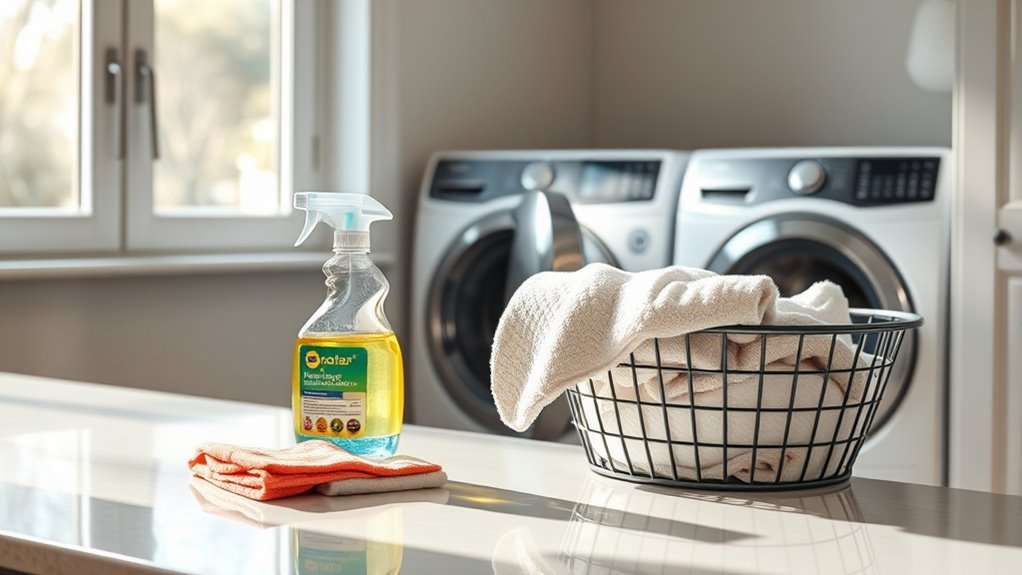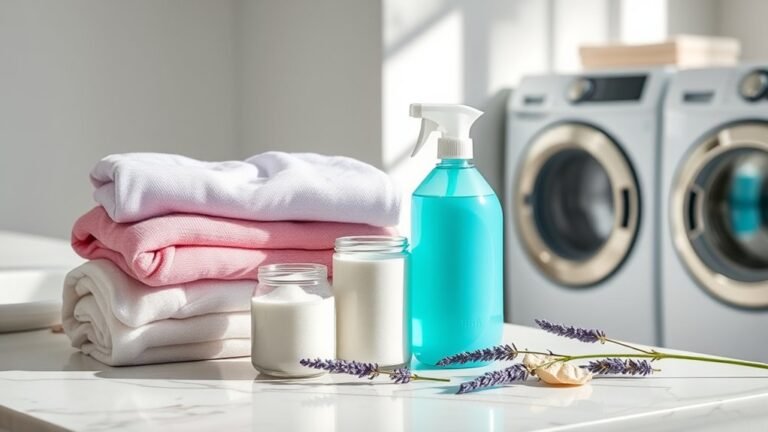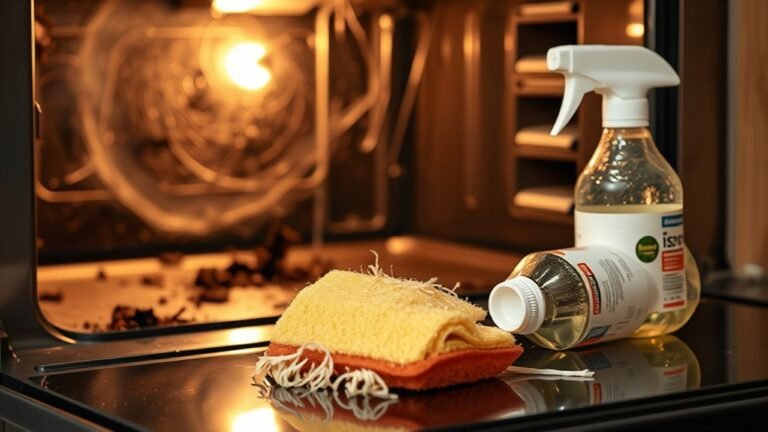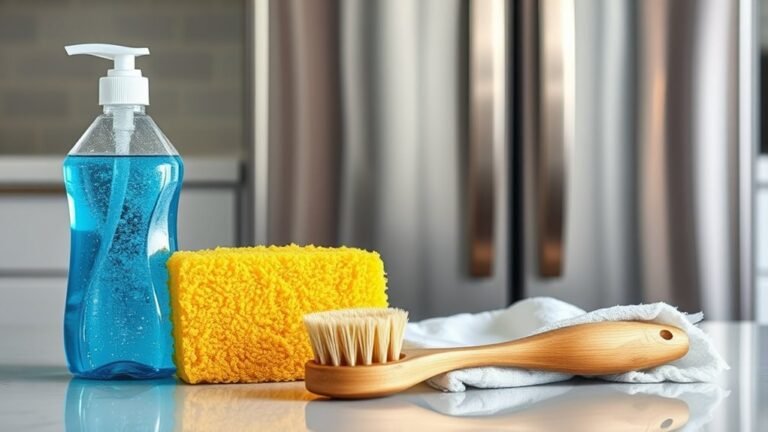Deep Cleaning Checklist for Laundry
To deep clean your laundry, start by running a hot cycle with vinegar to clear detergent buildup and wipe the washing drum, gasket, and dispenser. Clean the dryer lint trap and vent to improve airflow. Wipe washer and dryer exteriors weekly, and sanitize your laundry sink and faucet. Wash baskets monthly, and vacuum behind appliances safely. Don’t forget to mop floors and wipe walls. Keep following to master these tasks and maintain a spotless, efficient laundry space.
Cleaning the Washing Machine Drum
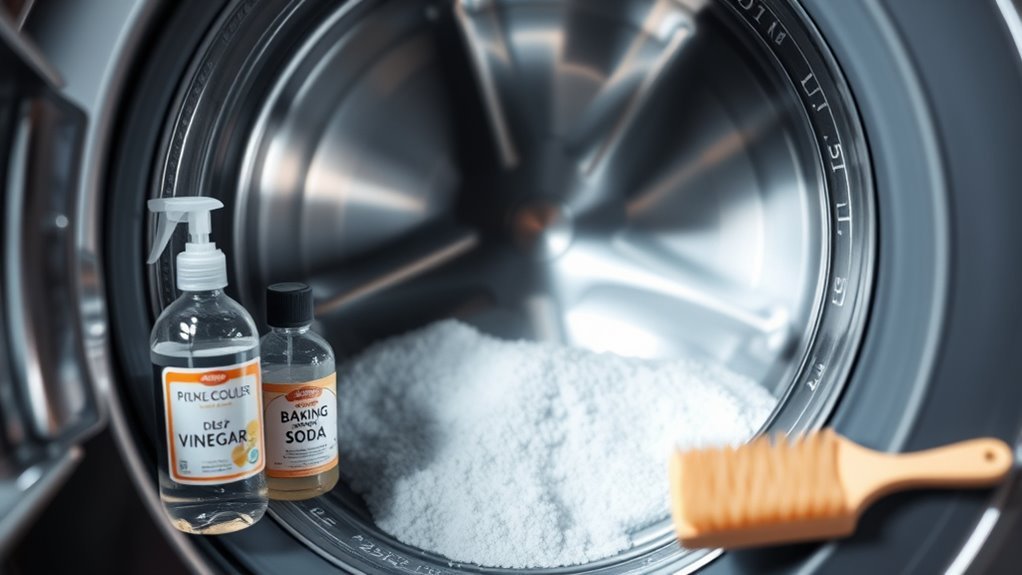
Before you start cleaning your laundry, it’s important to tackle the washing machine drum, as buildup from detergent, fabric softener, and dirt can cause odors and reduce efficiency. For effective drum maintenance, set a regular cleaning frequency—ideally once a month if you use your washer frequently. Begin by running an empty hot water cycle with a washing machine cleaner or white vinegar to break down residues. After the cycle, wipe the drum, door seal, and detergent dispenser thoroughly with a microfiber cloth to remove any lingering grime. Leave the door open to allow the drum to dry completely, preventing mold growth. Staying consistent with this drum maintenance routine guarantees your washer runs smoothly, keeps your laundry fresh, and frees you from unwanted odors and costly repairs down the line.
Removing Detergent and Fabric Softener Residue
After ensuring your washing machine drum is clean, the next step is to focus on removing detergent and fabric softener residue that can build up in your machine. This detergent buildup can cause odors, reduce efficiency, and leave clothes less fresh. To tackle this, follow these steps:
- Run an empty hot water cycle with two cups of white vinegar to dissolve residue.
- Add half a cup of baking soda during the rinse cycle to neutralize odors and loosen buildup.
- Consider fabric softener alternatives like wool dryer balls or vinegar rinses to prevent future residue.
Sanitizing the Washing Machine Gasket and Door Seal
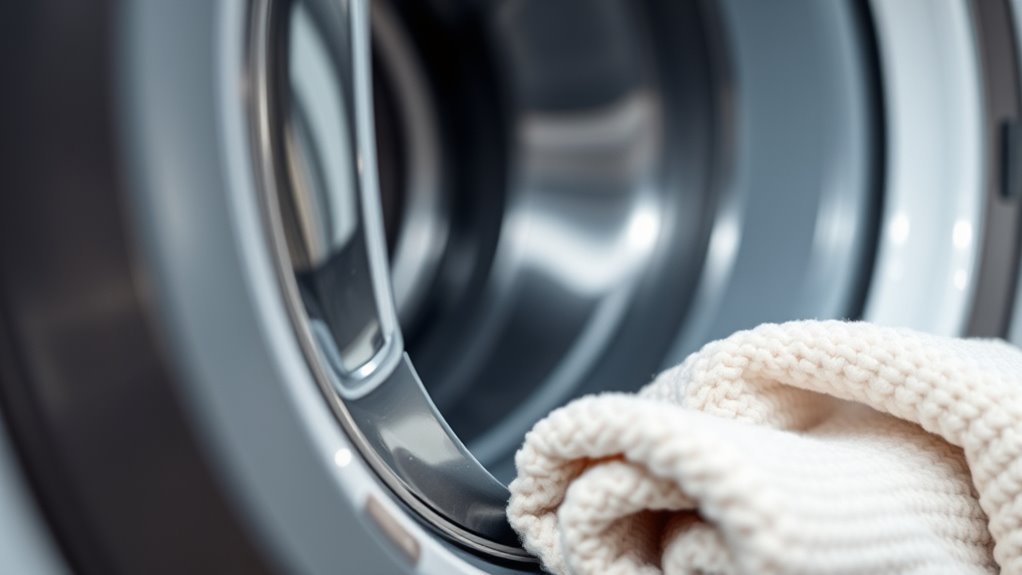
Though it’s easy to overlook, sanitizing the washing machine gasket and door seal is essential to prevent mold, mildew, and unpleasant odors. Start by pulling back the gasket to check for trapped debris and moisture. Regular seal inspection helps you spot cracks or wear early, ensuring gasket maintenance is effective. Use a mixture of equal parts water and white vinegar or a mild bleach solution to wipe down the gasket thoroughly. Pay close attention to crevices where grime collects. After cleaning, dry the area completely with a clean cloth to prevent moisture buildup. Leaving the door open after each wash also helps keep the seal dry and fresh. Following these steps gives you freedom from stubborn odors and extends your machine’s lifespan.
Cleaning the Dryer Lint Trap and Vent
Two essential steps will keep your dryer running efficiently and safely: cleaning the lint trap and clearing the vent. Regular lint removal techniques prevent clogs that reduce airflow and increase fire risk. Start by removing lint from the trap after every load. Next, follow these vent maintenance tips:
Keep your dryer safe and efficient by cleaning the lint trap after each load and regularly clearing the vent.
- Detach the vent hose and use a vent brush to clear accumulated lint inside.
- Vacuum the vent opening and the duct leading outside to remove stubborn debris.
- Inspect the exterior vent cap for blockages and make certain it opens freely.
Wiping Down the Washer and Dryer Exterior
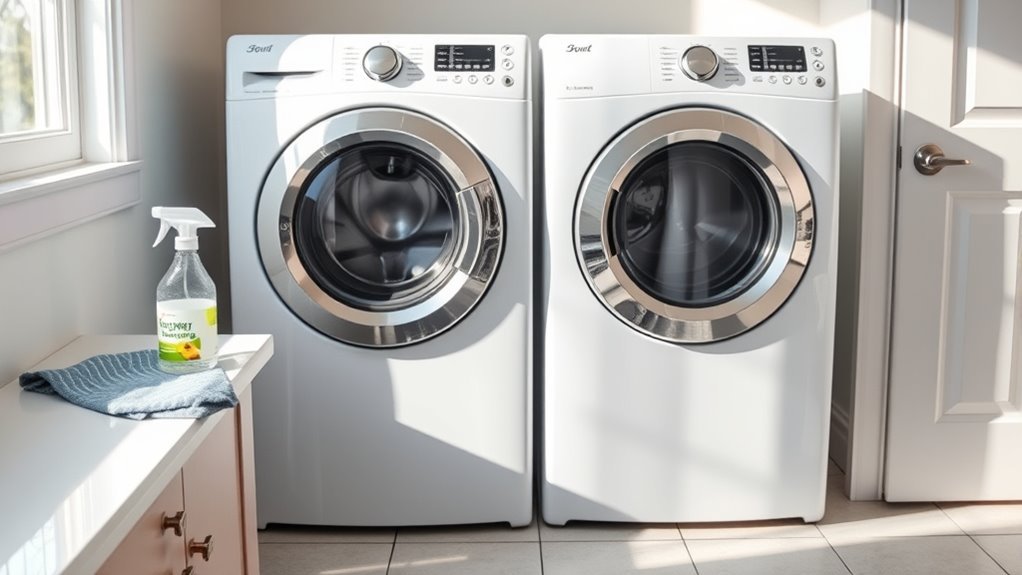
To wipe down your washer and dryer exterior effectively, start by selecting a soft cloth and a gentle, non-abrasive cleaner. Follow a consistent step-by-step process: dampen the cloth, wipe in circular motions, and dry immediately to avoid streaks. Be careful to avoid harsh chemicals or excessive moisture that could damage the surfaces.
Choosing Cleaning Materials
When selecting cleaning materials for wiping down your washer and dryer exterior, you’ll want products that effectively remove dirt and grime without damaging the surfaces. Opt for eco friendly products to keep your laundry space safe and reduce environmental impact. Choose gentle but efficient cleaning solutions that won’t strip finishes or leave residue.
Here are key materials to take into account:
- Microfiber cloths: They trap dust and dirt without scratching surfaces.
- Mild, plant-based cleaning solutions: These offer powerful cleaning with minimal chemicals.
- Spray bottles: For even application of your chosen cleaning solution.
Avoid harsh abrasives or bleach-based cleaners, as they can dull or damage your appliances. By picking the right materials, you maintain your washer and dryer’s look while enjoying safer, greener cleaning.
Step-by-Step Wiping Process
Although the exterior of your washer and dryer might seem straightforward to clean, following a precise wiping process guarantees you remove all dirt and prevent damage. Start by unplugging the machines for safety. Use a soft microfiber cloth dampened with a mild cleaner. Apply wiping techniques that move in gentle, circular motions, focusing on buttons, handles, and edges where grime accumulates. Avoid harsh scrubbing to maintain the finish. For stubborn spots, let the cleaner sit briefly before wiping. Afterward, use a dry cloth to remove moisture and prevent streaks. Maintain a regular cleaning frequency—ideally once a week or after heavy use—to keep your appliances looking fresh and functioning well. This routine supports your freedom from persistent dirt and extends your machines’ lifespan.
Preventing Damage and Streaks
Keeping your washer and dryer free from damage and streaks starts with the right wiping techniques. To maintain ideal fabric care and guarantee stain prevention, use gentle, effective methods on the exterior surfaces. Avoid harsh chemicals that can harm finishes or leave residues attracting dirt. Follow these steps for streak-free results:
- Use a soft microfiber cloth dampened with a mild detergent solution to gently wipe surfaces.
- Dry immediately with a clean, dry cloth to prevent streaking or water spots.
- Regularly clean control panels and knobs with a slightly damp cloth to avoid buildup without damaging sensitive electronics.
These simple actions help preserve your appliances’ finish and functionality, giving you freedom from constant maintenance worries while supporting your fabric care routine.
Organizing Laundry Supplies and Storage Areas
Start by sorting your laundry supplies by type to keep everything easy to find. Use shelves, bins, or baskets to maximize your storage space efficiently. Finally, label each container clearly so you can grab what you need without any hassle.
Sorting Supplies by Type
Organizing your laundry supplies into distinct categories makes both cleaning and restocking much easier. Start by sorting your items based on their function and type. Separate detergent types—liquid, powder, and pods—to avoid confusion and guarantee quick access. Group fabric softeners together, whether liquid or dryer sheets, so you can grab what you need without hunting. Also, keep stain removers and specialty cleaners in their own section to streamline your process.
- Detergent types: liquid, powder, pods
- Fabric softeners: liquids, dryer sheets
- Stain removers and specialty products
Maximizing Storage Space
Although laundry areas can be limited in size, you can maximize storage by using vertical space and multi-functional organizers. Focus on shelf organization by installing adjustable shelves that accommodate various supply sizes. Utilize vertical storage with wall-mounted racks or pegboards to keep essentials accessible yet off counters. Combine baskets and bins on shelves to group like items, reducing clutter and freeing up floor space.
| Storage Solution | Benefit |
|---|---|
| Adjustable Shelves | Custom fit for all supply sizes |
| Wall-Mounted Racks | Keeps items within reach, saves floor space |
| Pegboards | Flexible tool and accessory storage |
| Bins & Baskets | Group supplies, simplify access |
Labeling Containers Clearly
When you label containers clearly, you’ll save time and reduce frustration by quickly identifying laundry supplies. Implementing effective labeling systems guarantees everything has its place, helping you maintain order and freedom in your laundry area. Choose container types that suit your storage space—whether stackable bins, clear jars, or pump bottles—and label them visibly.
Here’s how to optimize your labeling system:
- Use waterproof labels or laminated tags to withstand moisture.
- Include specific details like detergent type, scent, and usage instructions.
- Color-code labels to differentiate between cleaning agents, fabric softeners, and stain removers.
Cleaning the Laundry Sink and Faucet
Since your laundry sink and faucet are exposed to detergent residues, dirt, and mildew, regular deep cleaning is critical to maintain hygiene and functionality. Start by removing debris and rinsing the sink thoroughly. Use a disinfectant spray or a bleach solution to guarantee effective sink disinfecting—let it sit for 5-10 minutes before scrubbing with a brush. Pay special attention to corners and drain areas where grime accumulates. For the faucet, wipe down with a mild cleaner, then polish with a microfiber cloth to restore shine and prevent water spots. Don’t forget to clean the aerator by unscrewing it and soaking it in vinegar to dissolve mineral deposits. This routine keeps your laundry area fresh, bacteria-free, and your faucet looking brand new.
Washing Laundry Baskets and Hampers
To keep your laundry baskets and hampers fresh, start by identifying their material—plastic, wicker, or fabric—and choose cleaning methods accordingly. Aim to clean them at least once a month to prevent buildup and odors. For stubborn smells, use a mixture of vinegar and baking soda to neutralize and eliminate odors effectively.
Basket Material Types
Choosing the right material for your laundry basket or hamper is essential for effective cleaning and durability. Different materials impact how you maintain and use your laundry storage. Here’s what you should consider:
- Plastic baskets: Lightweight, easy to wipe down, and resistant to moisture. Perfect if you want a low-maintenance option that won’t harbor mold.
- Wicker hampers: Stylish and breathable, but they require gentle cleaning and regular airing to prevent mildew and deterioration.
- Fabric baskets: Flexible and often collapsible, but they need frequent washing and drying to avoid odor buildup.
Selecting a material that fits your lifestyle guarantees your laundry basket stays clean longer and lasts through many wash cycles. Choose wisely to enjoy both freedom and functionality in your laundry routine.
Cleaning Frequency Tips
Although it might not be your first thought, regularly washing your laundry baskets and hampers is essential to prevent odor, mold, and bacteria buildup. To maintain freshness, integrate this task into your laundry schedule. Frequency recommendations suggest cleaning plastic or metal hampers every two weeks, while fabric or wicker baskets should be washed or wiped down weekly, depending on usage. If you do laundry daily, consider cleaning hampers more often to avoid residue accumulation. Use warm water and mild detergent, then air dry completely to prevent moisture retention. Sticking to this routine frees you from unwanted smells and health risks, keeping your laundry area fresh and hygienic. Adjust the frequency based on your household’s size and laundry habits for best results.
Odor Removal Methods
One effective way to eliminate odors from your laundry baskets and hampers is by using a mixture of baking soda and vinegar. This combo tackles stubborn smells and serves as a powerful natural deodorizing technique. Start by emptying your basket, then sprinkle baking soda inside to absorb moisture and odors. Next, spray or wipe down the surfaces with a vinegar solution, which breaks down mildew and bacteria causing the smell. Let everything air dry completely to prevent mildew odors from returning. For ongoing freshness, remember to:
- Wash plastic or fabric hampers monthly with warm soapy water.
- Place dryer sheets or activated charcoal sachets inside baskets.
- Keep hampers in well-ventilated areas to reduce moisture buildup.
Following these steps will keep your laundry storage smelling clean and fresh, freeing you from persistent odors.
Checking and Cleaning Behind the Appliances
Before you start, make sure to unplug your washer and dryer for safety. Gently pull both appliances away from the wall to access the space behind them. This hidden area often collects dust, lint, and grime—common culprits that affect appliance performance. Use a vacuum with a crevice tool to remove hidden dirt from vents, hoses, and electrical connections. Wipe down the wall and floor behind the units with a damp cloth and mild detergent to prevent buildup. Inspect hoses for cracks or leaks as part of your appliance maintenance routine. After cleaning, carefully push the appliances back into place, ensuring hoses aren’t kinked. Regularly checking and cleaning behind your washer and dryer preserves efficiency and helps avoid costly repairs, giving you freedom from unexpected breakdowns.
Maintaining Laundry Room Floors and Walls
Floors and walls in your laundry room endure constant exposure to moisture, detergent spills, and lint buildup, making regular maintenance essential. For effective floor maintenance, start by sweeping or vacuuming to remove loose dirt and lint. Mop with a mild detergent solution to tackle detergent residues and prevent slipping hazards. When it comes to wall cleaning, wiping down surfaces with a damp cloth and a gentle cleaner prevents grime buildup and mold growth. Remember to:
- Use a soft brush or sponge on grout lines to avoid damage.
- Dry floors and walls thoroughly after cleaning to discourage mildew.
- Inspect for cracks or peeling paint, repairing promptly to maintain integrity.
Frequently Asked Questions
How Often Should I Deep Clean My Laundry Appliances?
You should follow frequency guidelines for deep cleaning your laundry appliances about every 3 to 6 months to guarantee peak performance. Regular appliance maintenance helps prevent buildup, odors, and mechanical issues. If you use your machines heavily or notice residue, clean them more often. Stick to these intervals to keep your appliances efficient and extend their lifespan, giving you more freedom from unexpected breakdowns and costly repairs.
Can I Use Vinegar to Clean My Washing Machine Safely?
Did you know over 50% of washing machines develop mold or mildew if not cleaned regularly? You can safely use vinegar to clean your washing machine—it’s a natural, effective way to remove buildup and odors. Just pour two cups of white vinegar into the drum and run a hot cycle. Vinegar benefits include breaking down soap scum and disinfecting surfaces, giving your machine a fresh, clean boost without harsh chemicals.
What Are the Best Detergents for Sensitive Skin?
If you have sensitive skin, you’ll want laundry detergents free from dyes, fragrances, and harsh chemicals to avoid irritation. Look for products labeled hypoallergenic or designed specifically for sensitive skin, like Seventh Generation Free & Clear or Tide Free & Gentle. These detergents clean effectively without causing reactions. Always check ingredient lists and opt for gentle formulas, so you can freely enjoy fresh, clean clothes without worrying about skin discomfort.
How Do I Prevent Mold in My Laundry Room?
To prevent mold in your laundry room, prioritize laundry ventilation by keeping windows open or installing an exhaust fan to remove damp air. Control moisture by wiping down surfaces and promptly fixing leaks. Use a dehumidifier if humidity stays high. Avoid leaving wet clothes in the washer or hamper for too long—dry them quickly to eliminate mold-friendly conditions. These steps give you freedom from mold worries and keep your space fresh.
Are There Eco-Friendly Laundry Cleaning Tips?
Did you know switching to eco-friendly detergents can reduce water pollution by up to 60%? To keep your laundry green, use plant-based detergents and natural fabric softeners like vinegar or wool dryer balls. Avoid harsh chemicals that harm the environment and your freedom to live toxin-free. Also, wash clothes in cold water to save energy. These simple swaps help you clean effectively while protecting the planet and your health.
